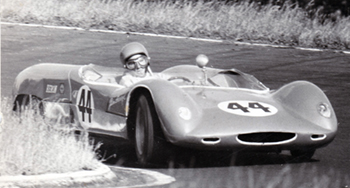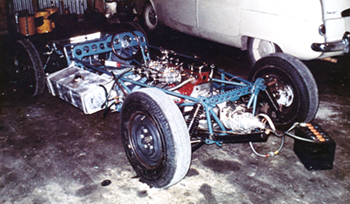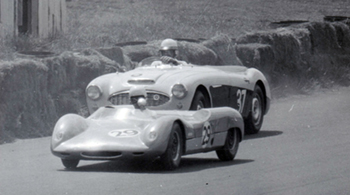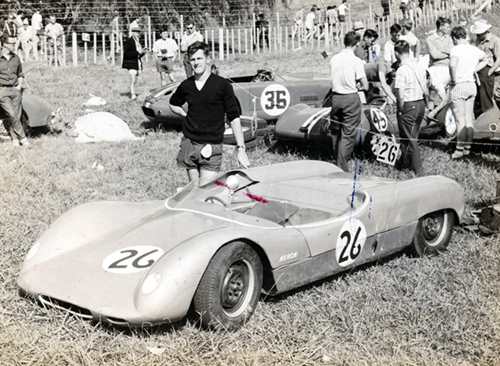Heron Mk1
by Patrick Harlow

Heron Mk1 Sports Racer at Pukekohe in 1962. Pete Akeroyd driving. 
The brazed tubular chassis weighed only 35kg. 
|
Work started on the Heron Mk1 during 1962. It was a car similar in looks, at least, to the Lotus 23B. With the Mk1, Ross would formulate a design process which would be repeated with each car he created over the ensuing years. As always, with anything he built, Ross would first start by spending many hours designing and drawing out his ideas until he felt that he had the ultimate design. In those days mid-engined cars were still not very common. The Mk1 Heron had a space frame chassis, aluminium body, 1500cc Cortina engine, VW transmission and a lightened Triumph Vitesse front suspension, brakes and rack etc. The chassis was built from 25 and 19mm x 0.8mm thick Reynolds tubing, the same sort of tubing as used on pushbikes of the day. Once all the tubes had been Fluxicote bronze welded together, Ross had a chassis that weighed only 35kg. Ross wanted the new car to be more competitive than the Mistral, in both handling and speed. . Ross designed and cast side plates for the gearbox and used Austin Mini drive shafts and welded feet onto front Mini hubs and used them for rear uprights. The car used coil-over suspension and disc brakes all round. To make the Cortina engine go faster, Ross purchased a Cosworth head from well-known racing driver, Roly Levis,and added twin 40mm Webber carbs, racing camshaft, balanced and extractors. |
|
The body was formed by bending 5mm rod over the chassis to gain the desired shape, then Eddie Jones, a well-known panel beater in Rotorua, formed the aluminium body over the wireframe, which was discarded once the body was finished. Eddie had worked on aluminium aircraft during the war and was an expert in this field. Firestone supplied the tyres, which were 520 x 13 front and 640 x 13 rear on steel wheels. The completed car weighed only 400kgs and took Bob Gee and Ross six months to build in their spare time. At its first outing, the Heron Mk1 won its first race by a considerable margin. From that point forward it continued to be successful, with podium finishes, at all of its future race events until the 1963 Grand Prix when it was running second, behind the Lycoming in the open sports car race. The Lycoming is another famous New Zealand race car. It was going well until the clutch slave cylinder piston on the Heron jammed, right on a hairpin bend. Ross was forced to retire. A highlight of this inglorious end was that he had the opportunity to talk to the racing legend Graham Hill. Having seen the car, Graham took a great interest in the Heron and the two had a long talk about building cars. At the end of the 1963 season, Ross sold the car to Peter Ackeroyd. |

|









